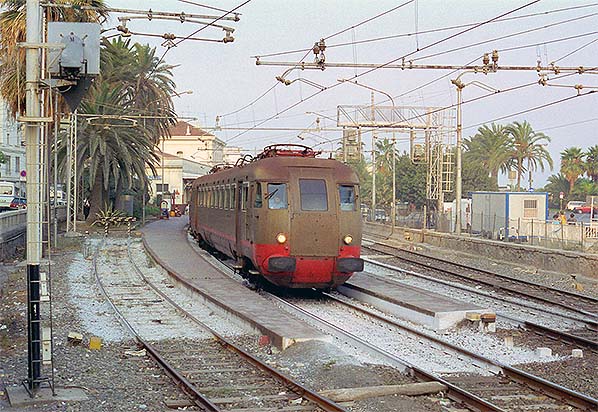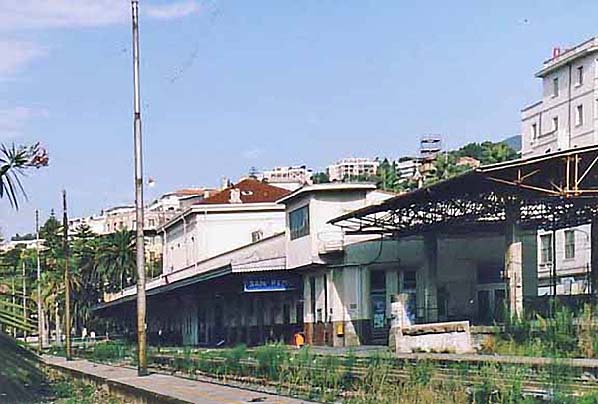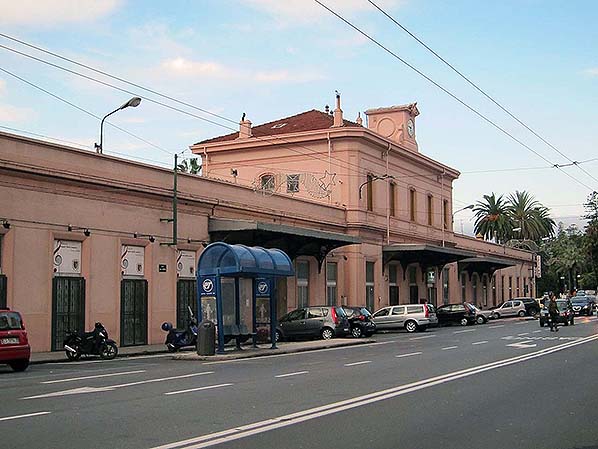
Station Name: SAN REMO (Italy) A 735 class 2-8-0 steam loco is seen at San Remo station in April 1965. It is unclear why this locomotive was as San Remo in 1965 as there were no steam services running though the city in the 1960s. This class, built for freight haulage, numbered nearly 400, the last being withdrawn in 1971. The class were built by Montreal Locomotive Works which was a subsidiary of ALCO (American Locomotive Company); MLW built around two-thirds of the class with ALCO building the remainder. One of them, No. 735.236 was used in the 1965 film 'Von Ryan's Express.' A 735 class 2-8-0 steam loco is seen at San Remo station in April 1965. It is unclear why this locomotive was as San Remo in 1965 as there were no steam services running though the city in the 1960s. This class, built for freight haulage, numbered nearly 400, the last being withdrawn in 1971. The class were built by Montreal Locomotive Works which was a subsidiary of ALCO (American Locomotive Company); MLW built around two-thirds of the class with ALCO building the remainder. One of them, No. 735.236 was used in the 1965 film 'Von Ryan's Express.'Photo by Nick Catford 
Vintage electric locomotives beside the sea at San Remo in 1966. On the left is 431 Class No. E431.031 with another, unidentified, locomotive coupled behind it, while on the right is 432 Class No. E432.002. Introduced in 1922 and 1928 respectively, both classes had a 1-D-1 wheel arrangement (equating to 2-8-2 in steam locomotive terms). Electric locomotives of this era were very different to those of today in several ways. For example Classes 431/2 made use of 'liquid rheostats', comprising a solution of water and sodium carbonate plus a fresh water tank for cooling purposes. As such, these locomotives were well known for emitting steam, via a vent which is visible on top of No. E432.002's nose end. From time to time the water had to be topped up, providing the odd sight of an electric locomotive at a water column. Very obvious are the twin overhead wires with twin contact strips on the pantographs, the reason being the supply: 3,600VAC three-phase at 16 2/3 cycles (Hz). These locomotives were originally fitted with trolley poles with skate devices which probably proved unsatisfactory at speed. Today FS (Ferrovia dello Stato - Italian State Railways) uses 3,000VDC for its conventional lines and 25kV AC for its high speed lines. The three-phase system, which was complex, was gradually phased out and the final pockets disappeared in 1976. Examples of both locomotive classes seen here have survived into preservation but 431.031 and 432.002 are not among them.
Photo by Bob Cable  Postcard view looking north-east along the single track coastal line towards San Remo c1960s. San Remo station is seen on the curve in the middle distance
 A Class ALe 540 electric railcar pulls into San Remo station in August 1992. Class ALe 540s dated from 1955 and were unusual in being First Class only. They worked with, or could work with, Class ALe 660 which had both First and Second Class accommodation. They worked both local and medium distance services, having a decent turn of speed for a railcar of their era; 150km/h which is roughly 93mph. A Class ALe 540 electric railcar pulls into San Remo station in August 1992. Class ALe 540s dated from 1955 and were unusual in being First Class only. They worked with, or could work with, Class ALe 660 which had both First and Second Class accommodation. They worked both local and medium distance services, having a decent turn of speed for a railcar of their era; 150km/h which is roughly 93mph.Photo by Giorgio Stagni 
Against a typical backdrop of Liguria's Mediterranean coast, E636 Class locomotive No. 072 waits with a train heading towards Ventimiglia. Note the lowered, ramped, section of platform to accommodate the crossing. There were one or two examples of this in Britain but on continental railways with lower platforms it was more common. The FS 636 Class locomotives were a Bo-Bo-Bo articulated design deemed suitable for certain of Italy's more tortuous routes. The two units making up the locomotives were, externally at least, identical and each only had a cab door on the right side which gave one cab door per side of the complete locomotive. The aesthetics of the design may not have been to everybody's taste, perhaps not helped by the reddish-brown livery. In later years other liveries were applied which considerably improved the aesthetics. The E636 Class originated during the Second World War, 1940 to be precise, and built in batches until 1962 resulting in a fleet strength of 469. No. 072 was one of the original wartime batch. From the technical aspect they were very simple locomotives, which may account for the fact the last examples were not withdrawn from service until 2006. The Bo-Bo-Bo arrangement was perpetuated with later classes, of which some remained in service at the time of writing.
Photo by Stefan Wohlfahrt
 San Remo goods facilities in July 1987. The goods shed was adjacent to and north of the main station building. The diesel shunter is a a Class 214 diesel-hydraulic No. 4022. A total of 490 were built by several manufacturers using several makes of diesel engine. No. 4022 is from a batch built from the late 1970s and into the 1980s and has a Vancini - Martelli (usually abbreviated to 'VM') engine. They're very small locos and can only manage about 90 - 100hp depending on engine fitted, which is adequate - just - for their intended purpose. Ten or so years ago a number of them remained in service with Trenitalia (the operating arm of FS - the Italian State Railway) but it's not known how many are still working.
Photo by Tim Vincent from his Flickr photostream  The new San Remo station under construction.
The new station connects to the platforms by a 500 metre subway with a travelator. 
San Remo station looking north in July 2001, two months before closure. A lot of passengers wit on the northbound platform while others are seen crossing the line.
Photo by Aleksandar Salatic 
The station buildings at San Remo in July 2002, nine months after closure. The track bed is overgrown but the track is still in place. The overhead power lines have been removed. The station goods facilities are seen on the right.
Photo by Aleksandar Salatic  San Remo station building c2002 shortly after track lifting.
Photo by Ginevra Bianchi  San Remo station frontage in 2011. Today the station is largely empty awaiting a new user. San Remo station frontage in 2011. Today the station is largely empty awaiting a new user.Photo by Emanuele Rava

The new San Remo station in December 2012, The new section of the coast line between between Ospedaletti and S.Lorenzo al Mare, is built entirely in tunnels.
Photo by Emanuele Rava 
|
 The main station building at San Remo station looking north-east in December 2012. A long distance cycle way now occupies the track bed.
The main station building at San Remo station looking north-east in December 2012. A long distance cycle way now occupies the track bed.
 Home Page
Home Page